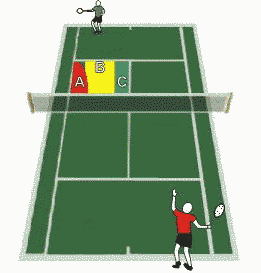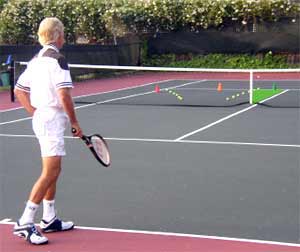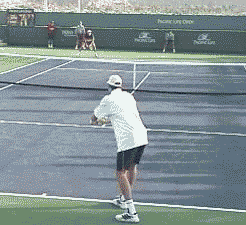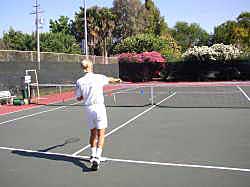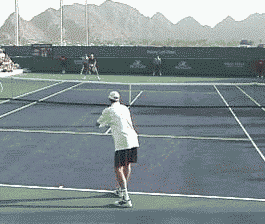|
TennisOne Lessons
Strokes and Strategy: The Serve and Placement Ken DeHart
What is the most important shot in tennis? It has to be the serve, because it is the stroke that begins every point and it allows the server to dictate the tone and strategy of the point as well. When serving, you have three weapons to work with: speed, spin, and placement. It's unfortunate that when many club players serve they fall prey to the Tom Cruise Top Gun mentality, “I feel the need for speed.” These players are relying too heavily on one dimension of serving. In baseball, even if you have a 90 mile an hour fastball, it won't be effective unless you have some off-speed pitches and you can throw to a certain spot in the strike zone. The same principles of variation and directionality apply in tennis. In this article, we'll focus on placement, one of the three weapons you should have in your serving arsenal. The Three Zones
Last week I watched Akiko Morigami play Jennifer Capriati in the third round at Wimbledon. Morigami had a break point against her then threw in three service winners to close out the game; one into the body, one out wide, and one down the center. Morigami's serve is far from the biggest in the women's game. In fact, she has a hard time reaching 100mph. What Morigami demonstrated is that you don't need a huge serve for it to be effective. Placement is the key, and thinking about service placement is as simple as thinking about ABC:
The secret to serving to a given location is learning to visualize that location. There is truism in tennis: we hit what we can see. So before we can place our serves in a given location, we have to learn to see those locations. Therefore, we're going to color-code the ABC serving targets. We use red for the Alley zone because serving to the Alley is dangerous or risky. You are hitting over a higher part of the net and you're serving into a small part of the service box. Serving to the yellow or Body zone is the safest serve as it is the largest segment in the center of your general target area, which is the service box. Although the body serve is the highest percentage serve, it's the most the most underused serve in tennis. Again, players tend to be mesmerized by the desire to hit aces, which usually go down the center or into the alley. The green Center zone is where you hit most of your aces. Going down the Center in the deuce court also allows you to hit to the backhand of the receiver (if your opponent is right handed), where he or she can't do as much to hurt you. (Although, it's not always the “weaker” side, as many players are steadier off their backhand side.) Visualizing Your Target ZonesWhen picking out your serve targets, here's a few tricks you can use to help visualize your target area. Again, if you can see it, you can hit it.
If you want to serve down the center, look through the net and keep the center service line and the net strap in your field of vision. You'll see that the center serve zone has a triangular shape, like a slice of pie. Visualizing this pie helps you serve to your favorite spot, the green zone. The target for the yellow zone is easy: your opponent's body. The target for the alley is more difficult to visualize. But if you look through the net, you can see the alley line running up towards the receiver and you can visualize another piece of pie in the service box. Placement TacticsForm the mental habit prior to every serve of consciously choosing a target. In choosing your target, be aware that choosing the Alley zone is risky and therefore should be selected less frequently (unless you see some glaring weakness in your opponent's game). Mixing up your serves, and occasionally serving into the Alley, can pay dividends. A serve into the Alley, especially if the serve is hit with slice or spin, pulls the receiving player wide, opening up the court so you can hit your next shot into a wide open court.
The Body serve is a good choice anytime, but if you're playing a tall or fast player, you're much better off serving into the body, limiting your opponent's striking power and ability to move and create return angles off your serve. Serving down the Center on your first serve gives you a chance for an ace or a winner. Serving a slower first serve or a second serve to the Center also enables you to limit the receiver's return angles. Typically the receiver will return down the center, and this opens up angles for you, allowing you to go deep to your opponent's forehand or backhand. Practicing on Your OwnTo practice visualizing the three target zones, lay several balls in a line to divide the court into the Alley zone, Body zone, and Center zone.
Next try to hit five balls into each zone. Typically, players will try to hit the ball too hard to build up their placement skills, so start this drill from the service line. Moving closer to the net will help you relax, and give you better focus on controlling your serve and placement. As you build your confidence, you can move halfway between the service line and baseline, and then finally to the baseline. The basketball equivalent of this drill would be shooting layups, free-throws, and then 3-point shots. You don't want to start you're warm-up by shooting 3-point shots. If you become inconsistent, then simply move back towards the net so you can build your confidence. Serve StrategyLet's start with first things first: the spin of the racquet to determine who serves first. The rules say you spin before you warm-up, and it's important to know this rule and all the tactical variables that go along with it. If you win the spin, should you choose to serve or return? There is no absolute answer here as it depends on too many variables: the time of day (if it's early morning and I'm not a morning person, then I choose to return); difficult sun position for serving; my level of confidence in either my serve or return. But spin before you warm-up, so that if you do choose to serve, you can serve on the side you're warming up on.
If you've chosen to serve the first game, take a lot of overheads during the warm-up. This helps you groove your service motion without giving your opponent too many looks at your serve (more on this later). When you're practicing your serve, don't let your opponent start to read your serve by serving exactly how and where you want to serve during the match. Many players do this because their confidence is low and they are apprehensive about getting their serves in during the first game. But with a more conservative approach to your first service game, you don't have to show your hand, so to speak, before the match begins. How should you approach your first service game? Your general strategy should be to warm-up your service motion and to gain confidence by placing a high percentage of first serves in. This also has an important benefit of depriving your opponent of too many looks at your serve at the beginning of a match, delaying the moment when the receiver feels comfortable returning your serve. It's not exaggeration to say that not giving your opponent a “lot of looks” at your serve in the first set can win you that first set. Let's return to the first few serves. As I'm not fully warmed-up and I want to get a high percentage of first serves in, my first serves will be spin serves at three-quarter speed down the middle, into the body of my opponent. The lower-speed and spin help me groove my serve and choosing the Body zone gives me a larger, safer target area. Serving into the body also forces my opponent to move out of his own way, which is difficult in the first game of a match.
I recommend most club players hit mostly spin serves throughout a match, with the goal of achieving a 60-70 first serve percentage. However, as the match progresses, you're more fully warmed-up, and you're confidence level is high (as you've been serving a high percentage of first serves), you can then start mixing up the placement and speed of your serve. Once you feel grooved, it's okay to go for a harder, flatter serve. But “harder” doesn't mean “all-out.” You still need to control your speed and placement to give yourself a good chance of getting that first flat serve in. Hit your first few flat serves out, and you're confidence will begin to drop off very quickly. You should also think about serving as a three shot sequence to winning a point. For example, if my opponent has a strong forehand and weaker backhand (which describes most club players), I might serve wide into his forehand. This pulls him off the court, allowing me to drive the ball deep into his backhand, thereby setting up an easy volley for the winner. Wrap-UpYou have three weapons to work with when serving: speed, spin, and placement. In this lesson we've focused on the ABCs of placement and some of the general strategic principles of serving. There's a lot of information here, and you certainly won't remember all this during the stress of a match. But start to build little reminders and rituals which will help you maintain your concentration and focus during a match. Think “ABC,” and you can remind yourself to vary your serve placement and you'll keep your opponent off-balance. Think “80 percent first serves in” as you step up to the service line in the first game and you're on your way to building momentum and winning more matches. Your comments are welcome. Let us know what you think about Ken DeHart's article by emailing us here at TennisONE . |

